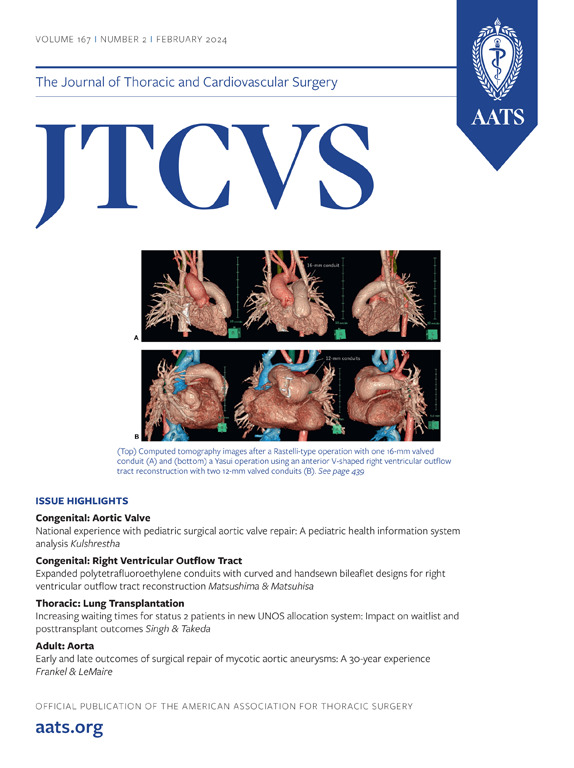Impact of dual thoracic recovery from circulatory death donors on heart and lung transplant outcomes
IF 4.9
1区 医学
Q1 CARDIAC & CARDIOVASCULAR SYSTEMS
Journal of Thoracic and Cardiovascular Surgery
Pub Date : 2025-02-01
DOI:10.1016/j.jtcvs.2024.07.008
引用次数: 0
Abstract
Objectives
Concomitant heart and lung recovery can result in increased operative complexity, ischemic time, and competition for resources and anatomic territory. Dual thoracic recovery from circulatory death donors may have additional risks that are not fully understood. We investigated the effects of dual heart and lung recovery from circulatory death donors on thoracic transplant outcomes.
Methods
Using the United Network for Organ Sharing database, we categorized all adult thoracic circulatory death donor transplants from 2019 to 2023 by whether the donor heart, lung, or both (dual donors) were recovered. Heart and lung transplant outcomes were compared between dual recovery donors and heart-only or lung-only donors, respectively, using multivariable analyses.
Results
Of the 2513 donors included, 42.9% were heart-only, 45.0% were lung-only, and 12.0% were dual donors. Recipients of dual versus heart-only donors had similar likelihood of post-transplant dialysis (18.9% vs 18.3%, P = .84), likelihood of stroke (2.9% vs 4.7%, P = .34), and 2-year risk of mortality (adjusted hazard ratio, 1.15 [95% CI, 0.90-1.47], P = .26), but lower likelihood of acute rejection (10.2% vs 16.1%, P = .04). Recipients of dual and lung-only donors had similar likelihood of predischarge acute rejection (7.6% vs 8.5%, P = .70), intubation at 72 hours (38.9% vs 45.1%, P = .13), and extracorporeal membrane oxygenation at 72 hours (13.1% vs 18.1%, P = .11), as well as 2-year risk of mortality (adjusted hazard ratio, 1.16 [95% CI, 0.74-1.82], P = .52).
Conclusions
Recovering both the heart and lungs from a circulatory death donor does not negatively impact transplant outcomes. Outcomes in this population should continue to be investigated as more data and longer-term follow-up become available.
循环死亡供体的双胸廓恢复对心肺移植结果的影响。
目的:同时进行心肺复苏可能会增加手术的复杂性、缺血时间以及对资源和解剖区域的竞争。从循环死亡供体(DCD)中进行双胸廓恢复可能会有额外的风险,而这些风险尚未得到充分了解。我们研究了DCD供体的双心肺复苏对胸腔移植结果的影响:利用器官共享联合网络数据库,我们按照供体心脏、肺或两者(双供体)是否被回收对 2019-2023 年所有成人胸部 DCD 移植进行了分类。通过多变量分析,分别比较了双恢复供体与纯心脏或纯肺供体的心脏和肺移植结果:在纳入的 2513 名供体中,42.9% 为纯心脏供体,45.0% 为纯肺供体,12.0% 为双供体。双重供体与纯心脏供体的受者在移植后透析的可能性(18.9% 对 18.3%,P=0.84)、中风的可能性(2.9% 对 4.7%,P=0.34)和 2 年死亡风险(aHR 1.15 [95% CI:0.90-1.47],P=0.26)方面相似,但发生急性排斥反应的可能性较低(10.2% 对 16.1%,P=0.04)。双肺供体和纯肺供体的受者出院前发生急性排斥反应(7.6% vs. 8.5%,p=0.70)、72小时插管(38.9% vs. 45.1%,p=0.13)和72小时ECMO(13.1% vs. 18.1%,p=0.11)的可能性相似,2年死亡风险也相似(aHR 1.16 [95% CI: 0.74-1.82],p=0.52):结论:从DCD供体中同时回收心脏和肺部不会对移植结果产生负面影响。结论:从DCD供体中同时回收心脏和肺并不会对移植结果产生负面影响,随着更多数据和更长期随访的出现,应继续对这一人群的移植结果进行研究。
本文章由计算机程序翻译,如有差异,请以英文原文为准。
求助全文
约1分钟内获得全文
求助全文
来源期刊
CiteScore
11.20
自引率
10.00%
发文量
1079
审稿时长
68 days
期刊介绍:
The Journal of Thoracic and Cardiovascular Surgery presents original, peer-reviewed articles on diseases of the heart, great vessels, lungs and thorax with emphasis on surgical interventions. An official publication of The American Association for Thoracic Surgery and The Western Thoracic Surgical Association, the Journal focuses on techniques and developments in acquired cardiac surgery, congenital cardiac repair, thoracic procedures, heart and lung transplantation, mechanical circulatory support and other procedures.

 求助内容:
求助内容: 应助结果提醒方式:
应助结果提醒方式:


